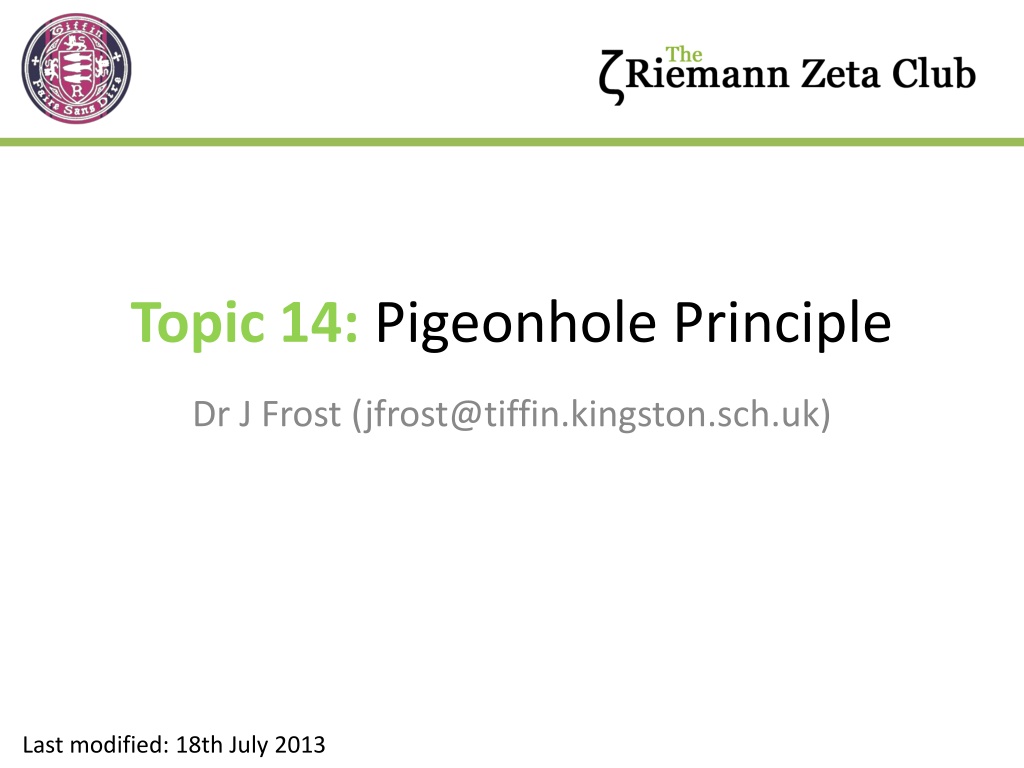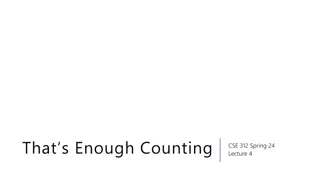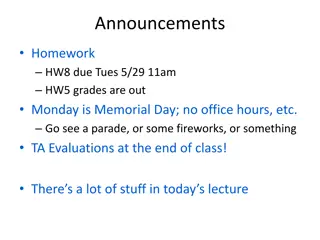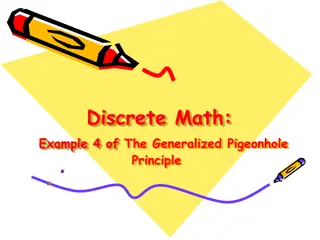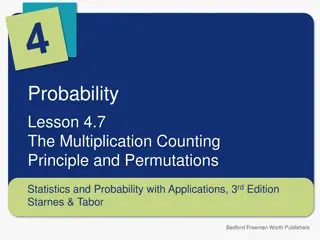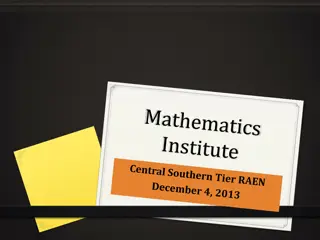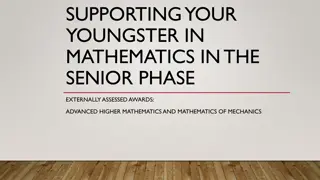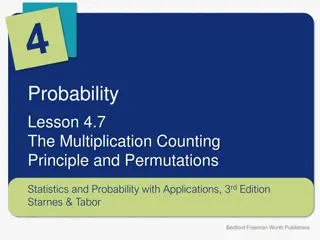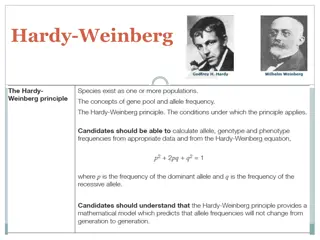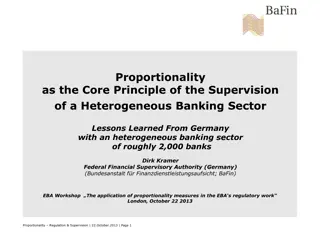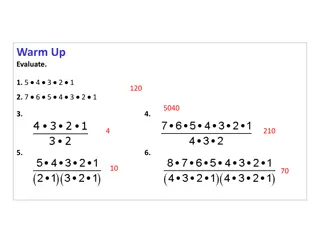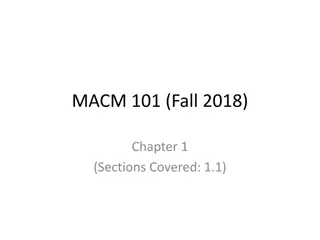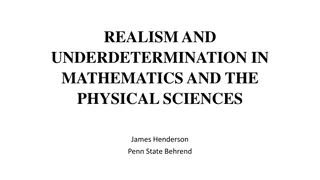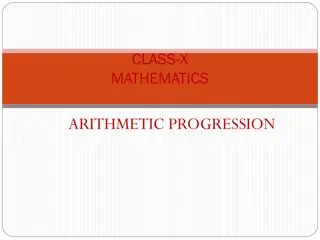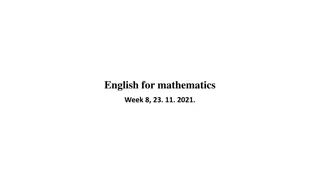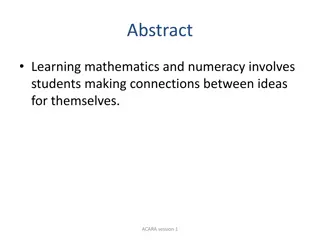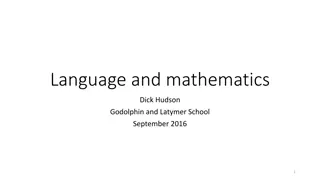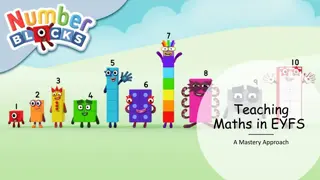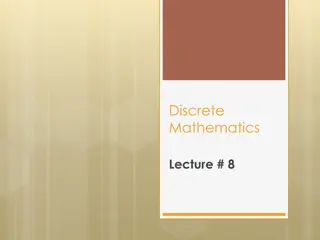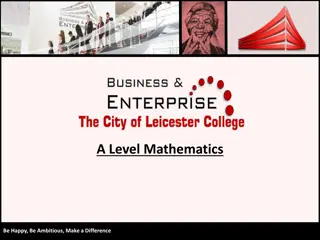Understanding the Pigeonhole Principle in Mathematics
The Pigeonhole Principle, demonstrated through examples and explanations by Dr. J. Frost, illustrates the concept that if you have more "pigeons" than "holes," then at least one "hole" must contain multiple "pigeons." This fundamental principle is essential in solving various mathematical problems involving allocation and distribution. Explore how this principle is applied in different scenarios to gain a deeper insight into its significance in mathematical reasoning.
Download Presentation

Please find below an Image/Link to download the presentation.
The content on the website is provided AS IS for your information and personal use only. It may not be sold, licensed, or shared on other websites without obtaining consent from the author. Download presentation by click this link. If you encounter any issues during the download, it is possible that the publisher has removed the file from their server.
E N D
Presentation Transcript
Topic 14: Pigeonhole Principle Dr J Frost (jfrost@tiffin.kingston.sch.uk) Last modified: 18th July 2013
Slide guidance Key to question types: SMC Senior Maths Challenge Uni University Interview Questions used in university interviews (possibly Oxbridge). The level, 1 being the easiest, 5 the hardest, will be indicated. BMO British Maths Olympiad Frost A Frosty Special Questions from the deep dark recesses of my head. Those with high scores in the SMC qualify for the BMO Round 1. The top hundred students from this go through to BMO Round 2. Questions in these slides will have their round indicated. Classic Classic Well known problems in maths. MAT Maths Aptitude Test STEP STEP Exam Admissions test for those applying for Maths and/or Computer Science at Oxford University. Exam used as a condition for offers to universities such as Cambridge and Bath.
Slide guidance Any box with a ? can be clicked to reveal the answer (this works particularly well with interactive whiteboards!). Make sure you re viewing the slides in slideshow mode. ? For multiple choice questions (e.g. SMC), click your choice to reveal the answer (try below!) Question: The capital of Spain is: A: London B: Paris C: Madrid
Starter Question Show that if I pack 5 different numbers from 1 to 8, at least two of them add up to 9. 1 2 3 4 5 6 7 8 There are four pairs of numbers which add up to 9: {1, 8}, {2,7}, {3,6}, {4,5}. For the numbers we choose, each must belong to one of the four pairs. But there s 5 numbers, so two must belong to the same pair. ? Solution:
The Pigeonhole Principle Imagine that we have a number of slots, or pigeon holes in which we can put letters. J Frost A Filch S Snape A Dumbledore R Hagrid R Lupin F Flitwick P Sprout The pigeonhole principle is very simple: if we have more letters than pigeonholes, then one of the pigeonholes must have at least one letter. * The Pigeonhole Principle is also sometimes known as Dirichlet s Box Principle.
The Pigeonhole Principle There s many problems in which we can model as pigeonholes. If we take the previous problem: 27 6 8 4 {1,8} {2,7} {3,6} {4,5} By the pigeonhole principle, as we used more numbers then pairs, two of the numbers must be in the same pair. The letters represent the numbers from 1 to 8 we choose. Each pigeonhole represents a number pair. In general, we use the pigeonholes to model possible values , and letters to model items , which is put into a pigeonhole hole according to its value.
Another Example of Modelling Question: Show that if we pick 5 cards from a pack, two must be of the same suit. Club Diamond Heart Spade Each pigeonhole represents a suit. The letters represent the cards we choose. We put it in the correct pigeonhole according to its suit. Since we have more cards than suits, one pigeonhole must have at least two cards in it, and thus at least two cards of the same suit.
Dijkstras Principle Given there are 8 pigeonholes and 18 letters, what can we say about the maximum number of letters in a pigeonhole? J Frost A Filch S Snape A Dumbledore R Hagrid R Lupin F Flitwick P Sprout When we spread out the letters as much as possible, we found that the maximum number of letters was 3. Dijkstra s Principle(just a variant of the Pigeonhole Principle ) states that all the maximum number of letters must be at least the average number of letters.
Dijkstras Principle J Frost A Filch S Snape A Dumbledore R Hagrid R Lupin F Flitwick P Sprout There average number of letters in each pigeonhole is 18/8 = 2.25. But since the maximum number of letters must be at least this, the minimum this maximum can be is the nearest whole number above, i.e. 3. In general, if there are n letters and k pigeonholes, there maximum letters in a pigeonhole must be at least: These special brackets are known as the ceiling function, which rounds the number up.
Dijkstras Principle A simple example: Question: There are 1000 people in the room. What is the minimum number of people that share the same birthday? Solution: 3. By the pigeonhole principle, the maximum number of birthdays is at least 1000/365 = 2.74. Therefore at least 3 people share the same birthday. ?
Restricted Allocation Sometimes how we put letters in some pigeonholes restricts how we put them in others. There are n people at a party, where each person can shake hands with others at the party (or if they re antisocial, no one at all), although they can only shake a given person s hand at most once. Show that at least 2 people must have had the same number of handshakes. .... Bob Jim Tim 0 1 n-1 n Solution: Each pigeonhole represents the quantity of handshakes a person had. Consider the edge cases : if someone shook hands with no one, the no one can have shook hands with everyone, and vice versa. Thus we only have n-1 available pigeonholes, but n items, so one pigeonhole must have at least 2 items. ? Click for solution ? Source: Uni + Classic
Minimal Arrangements Sometimes we re required to do some calculation (e.g. the sum) involving letters in the minimal valid pigeonhole arrangement. 20 cities are visited by up to 20 people each, such that no two cities are visited by the same number of people. ? a) Minimum total number of visitors to the cities: 190 ? b) Maximum total number of visitors to the cities: 210
The Lowest Maximum When we want to consider the lowest maximum, we spread out the letters as evenly as possible over the pigeon holes. Question: A cinema sells 31 tickets in total one evening, and each movie can be watched by up to 3 people (but won t screen if no one shows up). Show that the minimum number of movies seen by the same number of people is 6. Let s deconstruct the problem: ? What are the pidgeonholes? The number of people attending a screening. ? What are the letters? Each movie/screening. Source: Frosty Special
The Lowest Maximum When we want to consider the lowest maximum, we spread out the letters as evenly as possible over the pigeon holes. Question: A cinema sells 31 tickets in total one evening, and each movie can be watched by up to 3 people (but won t screen if no one shows up). Show that the minimum number of movies seen by the same number of people is 6. This means that Meerkatman was seen by 3 people. This letter thus represents 3 tickets. Bat man Spider man Meerkat man 1 2 3 The arrangement that will minimise the maximum number of letters in a pidgeonhole (i.e. minimising the number of movies same by the same number of people) involves putting 1 letter in each pidgeonhole each time. Each time we do so, this represents 1 + 2 + 3 = 6 tickets. Source: Frosty Special
The Lowest Maximum When we want to consider the lowest maximum, we spread out the letters as evenly as possible over the pigeon holes. Question: A cinema sells 31 tickets in total one evening, and each movie can be watched by up to 3 people (but won t screen if no one shows up). Show that the minimum number of movies seen by the same number of people is 6. Bat man Dog man Rat man Spider man Tiger man Vole man Rabbit man Lice man Ant man Cat man Fish man Fox man Lima man Ox man Ham man 1 2 3 Given that putting one letter in each pigeonhole represents 6 total tickets, we can put 5 letters in each ticket to get us to 30 tickets. Toucan man We have 1 ticket left. This must have been for a movie watched by 1 person. And thus, six movies were watched by the same number of people. (Although note that there s other solutions in which 6 movies were watched by the same number of people, e.g. Once we got to 4 letters in each hole, we could have put 2 letters in the 3 hole and one in the 1 hole the point is that we ve proved that 6 is the minimum)
BMO Problem Question:Let S be a subset of the set of numbers {1, 2, 3, , 2008} which consists of 756 distinct numbers. Show that there are two distinct elements, a, b of S such that a + b is divisible by 8. Things that might be going through your head when you see this problem: What are my pigeonholes and what are my letters? How might I be restricted in putting letters into pigeonholes? It sounds like from the question that we can have 755 numbers without any two of them adding to give a multiple of 8. The problem is therefore equivalent to show that 755 is the maximum numbers of numbers we can choose without this happening . BMO Round 2 Round 1
BMO Problem Question:Let S be a subset of the set of numbers {1, 2, 3, , 2008} which consists of 756 distinct numbers. Show that there are two distinct elements, a, b of S such that a + b is divisible by 8. 10 80 26 0 2 3 1 4 5 6 7 Whether the sum of a and b is divisible by 8 is equivalent to using the remainder of each of the numbers when we divide each by 8. e.g. If 15 + 9 is divisible by 8, then so is 7 + 1 (we ll encounter modulo arithmetic in the Number Theory topic). So make the pigeonholes 0-7, and put a number in this hole if it s remainder is that number when dividing by 8.
BMO Problem Question:Let S be a subset of the set of numbers {1, 2, 3, , 2008} which consists of 756 distinct numbers. Show that there are two distinct elements, a, b of S such that a + b is divisible by 8. We re restricted in how we can put letters in holes. 10 80 26 If there s any in the 3 hole, we can t put any the 5 hole because then we d have two numbers which add to 8. 0 2 3 1 Similarly, we could only have one number in the 4 hole; if there were two they d again add up to 8. The same applies for the 0 hole. 4 5 6 7
BMO Problem Question:Let S be a subset of the set of numbers {1, 2, 3, , 2008} which consists of 756 distinct numbers. Show that there are two distinct elements, a, b of S such that a + b is divisible by 8. 10 80 There s 2008 numbers, so 2008/8 = 251 letters belong to each pigeonhole (e.g. all the multiples of 8, of which there are 251, would go in the 0 pigeonhole). 26 0 2 3 1 We would put 251 letters in either hole 1 or 7. Similarly, we could put 251 in hole 2 or 6. And another 251 in hole 3 or 5. And we could put 1 in holes 0 and 4. That gives us 251 + 251 + 251 + 1 + 1 = 755. This therefore is the maximum number before two of the numbers add to a multiple of 8. With 756, we d therefore violate this property. 4 5 6 7
BMO Problem Question: A booking office at a railway station sells tickets to 200 destinations. One day, tickets were issued to 3800 passengers. Show that (i) there are (at least) 6 destinations at which the passenger arrival numbers are the same; (ii) the statement in (i) becomes false if 6 is replaced by 7 . Things that might be going through your head when you see this problem: What are my pigeonholes and what are my letters? What s the average number of people at each station? A station is limited in the number of people that can buy a ticket for there. For example, if 3800 all bought a ticket for the same station, there wouldn t be 200 destinations! So we must have to restrict the allocation of letters to pigeonholes in some way. BMO Round 2 Round 1
BMO Problem Question: A booking office at a railway station sells tickets to 200 destinations. One day, tickets were issued to 3800 passengers. Show that (i) there are (at least) 6 destinations at which the passenger arrival numbers are the same; (ii) the statement in (i) becomes false if 6 is replaced by 7 . Bath.... 20 ... Kings Cross Paris Oslo Hull 0 1 18 19 My solution: Model the pigeonholes as the number of tickets for a station. Let the letters be the stations (so Bath goes in pigeonhole 1 if 1 person is going to Bath). If there s 3800 passengers, and 200 destinations, there s an average of 19 people per station. Note that this relates to the average value of the pigeonhole, NOT the average number of letters in each pigeonhole. The key to this strategy is thinking how we allocate letters to pigeonholes so the average pigeonhole value is 19.
BMO Problem Question: A booking office at a railway station sells tickets to 200 destinations. One day, tickets were issued to 3800 passengers. Show that (i) there are (at least) 6 destinations at which the passenger arrival numbers are the same; (ii) the statement in (i) becomes false if 6 is replaced by 7 . Bath.... 39 ... Kings Cross Oslo Hull Kings Cross 0 1 37 38 We want to minimise the number of letters in each pigeonhole. The way to do this is put one letter in each of the pigeonholes 0 to 38. As highlighted earlier, this ensures the average people per destination is still 19 whilst minimising the number of stations with the same number of passengers.
BMO Problem Question: A booking office at a railway station sells tickets to 200 destinations. One day, tickets were issued to 3800 passengers. Show that (i) there are (at least) 6 destinations at which the passenger arrival numbers are the same; (ii) the statement in (i) becomes false if 6 is replaced by 7 . .... 39 ... Kings Cross Paris Bath Madrid Oslo Berne Hull Hell Kings Cross 0 1 37 38 We keep adding in this way for each 39 stations. Each time we do, this represents 0 + 1 + 2 + 3 + ... + 38 tickets. Using the standard summation formula, this gives 741 tickets. 741 goes into 3800 five whole times, so we have 5 letters in each of the pigeonholes 0 to 38 and have 741x5 = 3705 tickets. How do we deal with the remaining 95 tickets? The average per station needs to be 19, which means we re spreading these over 95/19 = 5 stations. So using the 17, 18, 19, 20 and 21 pigeonholes will do to keep the quantities of tickets for each station spread out.. Thus in the minimal case, 5 quantities of tickets will have 6 stations with that quantity. This proves (ii) as well, because we ve proved this minimum can be 6.
One final problem The mathematician Paul Erd s once asked a student what he wanted to when he graduated. The student said he wanted to be a mathematical researcher. Erd s said in response: Let ? . Prove that if you take a set ? of ? + 1 numbers from {1,2, ,2?} then you can find distinct ?,? ? such that ? | ?. ( ?|? means that ? divides ?)
i.e. Show that if you pick ? + 1 numbers from 1 to 2?, one must divide another. Big Hint: Suppose that each pigeonhole contains the integers of the form ?2?, for each odd number ?, i.e. the first contains numbers of the form 1 2?, the second of the form 3 2? and so on. Suppose n is 5. Then we have 5 odd numbers, 1, 3, 5, 7, 9, and the numbers in each pigeonhole (using the hint above) will be: 1,2,4,8 5,10 3,6 7 {9} ? We have 5 pigeonholes (as there are 5 odd numbers), but 5+1 = 6 numbers to pick. So by the pigeonhole principle, we ll have chosen at least 2 numbers from one set. And clearly the numbers in each set divide each other, since ?2?|?2? when ? ?.
Summary For some problems, we use can use pigeonholes to represent different values, and letters to represent items can have one of these values. Be careful how you model these. There are two forms of the pigeonhole principle: 1. If there are more items than pigeonholes, at least one of the pigeonholes has more than one item in it. (Also known as Dirichlet sBox Principle ) 2. If there are n items and k pigeonholes, then the maximum number of items in a pigeonhole is at least the average, n/k. (This is Dijkstra stake on the pigeonhole principle, although this variant is also know as the Fubini Principle ) Often, putting items in one pigeonhole prevents items from being added to another. When considering problems in which we wish the minimise the maximum number of letters in a hole, spread the letters out as much as possible, without violating any given/implied constraints.
Recommended Resource http://www.cut-the-knot.org/do_you_know/pigeon.shtml has a gigantic collection of problems from past international Olympiads (and elsewhere) concerning the pigeonhole principle.
